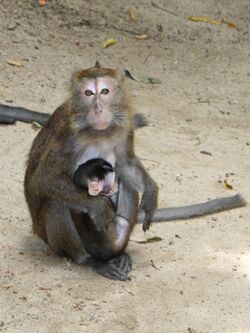Biology:Philippine long-tailed macaque
| Philippine long-tailed macaque | |
|---|---|

| |
| Philippine long-tailed macaque in Palawan, Philippines | |
| Scientific classification | |
| Domain: | Eukaryota |
| Kingdom: | Animalia |
| Phylum: | Chordata |
| Class: | Mammalia |
| Order: | Primates |
| Suborder: | Haplorhini |
| Infraorder: | Simiiformes |
| Family: | Cercopithecidae |
| Genus: | Macaca |
| Species: | |
| Subspecies: | M. f. philippensis
|
| Trinomial name | |
| Macaca fascicularis philippensis I. Geoffroy, 1843[2]
| |
The Philippine long-tailed macaque (Macaca fascicularis philippensis) is a subspecies of the crab-eating macaque, known in various Philippine languages as matching/matsing or the more general term unggoy ("monkey"). It is endemic to the Philippine forests and woodlands, but especially in the mangrove forests of western central Philippines — particularly in Palawan, the Visayas, and Mindanao. The names M. f. philippinensis and M. f. philippinenesis have also been used, but arise from orthographical error.[1]
Characteristics
The Philippine long-tailed macaque has a reddish-brown coat. It can reach a length of 890–1,200 mm (35–47 in). Its tail has an average length of 440 to 600 mm (1.44 to 1.97 ft).[3]:110–111 Males weigh 4–8 kg (8.8–17.6 lb), but females only attain 3–4 kg (6.6–8.8 lb).
Distribution and habitat
The Philippine long-tailed macaque is found on the Philippine islands of Balabac, Basilan, Biliran, Bohol, Busuanga, Camiguin, Catanduanes, Culion, Leyte, Luzon, northeastern Mindanao, Mindoro, Negros, Panay, Palawan, Samar, and Sibuyan. It has been found at elevations up to 1,800 metres (5,900 ft).[4]
Fossils
Fossils excavated in Palawan were identified as being of the Philippine long-tailed macaque, deer, Palawan bearded pig, Bornean tiger, small mammals, lizards, snakes and turtles. From the stone tools, besides the evidence for cuts on the bones, and the use of fire, it would appear that early humans had accumulated the bones.[5][6] In prehistoric times, the Greater Sunda Islands of Borneo might have been connected to Palawan during the penultimate and previous glacial periods, judging from the molecular phylogeny of murids.[7]
See also
- Puerto Princesa Subterranean River National Park, Palawan
References
- ↑ 1.0 1.1 Ong, P.; Richardson, M. (2008). "Macaca fascicularis ssp. philippensis". IUCN Red List of Threatened Species 2008: e.T40788A10354490. https://www.iucnredlist.org/species/40788/10354490. Retrieved 8 August 2021.
- ↑ Groves, C. P. (2005). "Macaca fascicularis philippensis". in Wilson, D. E.; Reeder, D. M. Mammal Species of the World: A Taxonomic and Geographic Reference (3rd ed.). Johns Hopkins University Press. pp. 111–184. ISBN 978-0-8018-8221-0. OCLC 62265494. http://www.departments.bucknell.edu/biology/resources/msw3/browse.asp?id=12100542.
- ↑ Heaney, L.R.; Balete, D.S.; Rickart, E.A. (2016). "Large mammals". The Mammals of Luzon Island: Biogeography and natural history of a Philippine fauna. Baltimore: Johns Hopkins University Press. p. 109–116. ISBN 9781421418377. https://books.google.com/books?id=JqijCwAAQBAJ.
- ↑ Eudey, A.; Kumar, A.; Singh, M.; Boonratana, R. (2020). "Macaca fascicularis". IUCN Red List of Threatened Species 2020: e.T12551A195354635. doi:10.2305/IUCN.UK.2020-2.RLTS.T12551A195354635.en. https://www.iucnredlist.org/species/12551/195354635. Retrieved 8 August 2021.
- ↑ Piper, P. J.; Ochoa, J.; Lewis, H.; Paz, V.; Ronquillo, W. P. (2008). "The first evidence for the past presence of the tiger Panthera tigris (L.) on the island of Palawan, Philippines: extinction in an island population". Palaeogeography, Palaeoclimatology, Palaeoecology 264 (1–2): 123–127. doi:10.1016/j.palaeo.2008.04.003. Bibcode: 2008PPP...264..123P.
- ↑ Ochoa, J.; Piper, P. J. (2017). "Tiger". in Monks, G.. Climate Change and Human Responses: A Zooarchaeological Perspective. Springer. pp. 79–80. ISBN 978-9-4024-1106-5. https://books.google.com/books?id=e-hyDgAAQBAJ&pg=PA80.
- ↑ Van der Geer, A.; Lyras, G.; De Vos, J.; Dermitzakis, M. (2011). "15 (The Philippines); 26 (Carnivores)". Evolution of Island Mammals: Adaptation and Extinction of Placental Mammals on Islands. John Wiley & Sons. pp. 220–347. ISBN 9781444391282. https://books.google.com/books?id=JmSsNuwMAxgC&pg=PT219.
Wikidata ☰ Q5435579 entry
 |


